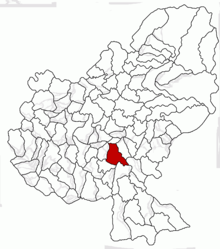Acățari
|
Acățari Aschdorf Ákosfalva |
||||
|
||||
| Basic data | ||||
|---|---|---|---|---|
| State : |
|
|||
| Historical region : | Transylvania | |||
| Circle : | Mureș | |||
| Coordinates : | 46 ° 29 ' N , 24 ° 38' E | |||
| Time zone : | EET ( UTC +2) | |||
| Height : | 322 m | |||
| Area : | 74.09 km² | |||
| Residents : | 4,738 (October 20, 2011) | |||
| Population density : | 64 inhabitants per km² | |||
| Postal code : | 547005 | |||
| Telephone code : | (+40) 02 65 | |||
| License plate : | MS | |||
| Structure and administration (as of 2016) | ||||
| Community type : | local community | |||
| Structure : | Acățari, Corbeşti , Găieşti , Gruişor , Murgeşti , Roteni , Stejeriş , Suveica , Vălenii | |||
| Mayor : | Csaba Osváth ( UDMR ) | |||
| Postal address : | Str. Principală, no. 100 loc. Acățari, jud. Mureș, RO-547005 |
|||
| Website : | ||||
Acățari [ acəˈtzarʲ ] (outdated Acoșfalău ; German Aschdorf or Achsdorf , Hungarian Ákosfalva ) is a municipality in the Mureș County , in the Transylvania region in Romania .
Geographical location
The municipality of Acățari is located north of the Kokel Valley (Podișul Târnavelor) in the southern part of the Mureș County. On the Niraj , a left tributary of the Mureș (Mieresch) and the national road Drum național 13 - part of the European route 60 - the place Acățari is ten kilometers southeast of the district capital Târgu Mureș (Neumarkt am Mieresch) .
The Vețca Canal traverses the municipality for about 22 kilometers .
Until around 2010, a narrow-gauge railway of the original narrow-gauge line from Cristeşti to Sovata (Szováta) operated on the area of the municipality .
history
The place Acățari was first mentioned in 1497 as a Szeklerort . Necropolises around the village church of the incorporated village of Vălenii (Hungarian Székelyvaja ) indicate that the community area was settled from around the 13th century .
In the Kingdom of Hungary , today's municipality belonged to the Maros alsó ("Under-Maros") district in the Maros-Torda County , then to the historical Mureș County and, from 1950, today's Mureș County.
population
The population of the municipality developed as follows:
| census | Ethnic composition | ||||
|---|---|---|---|---|---|
| year | population | Romanians | Hungary | German | other |
| 1850 | 5,026 | 647 | 4,080 | - | 299 |
| 1900 | 5,503 | 98 | 5,239 | 57 | 109 |
| 1941 | 6,295 | 25th | 6.121 | 5 | 144 |
| 2002 | 4,781 | 75 | 4,424 | 1 | 281 |
| 2011 | 4,738 | 91 | 4,067 | 2 | 578 (Roma 483) |
The highest number of inhabitants has been registered in the area of today's municipality since 1850 and that of the Magyars in 1941. The highest population of Romanians (793) was determined in 1920, that of Roma in 2011 and that of Romanian Germans in 1900.
Attractions
- Between several incorporated villages Murgeşti (Hungarian Nyárádszentbenedek ) and Roteni (Hungarian Harasztkerék ) is a Roman road and is a listed building.
- In the incorporated Szeklerdorf Vălenii (obsolete Oaia ) the reformed church built in the 13th century and renovated in the 19th, and the wooden church Sfântul Nicolae built in 1696, are listed.
- In the incorporated Szeklerdorf Murgeşti the reformed church.
- In the incorporated Szeklerdorf Roteni the new reformed church - on the place of an older one until 1794 - built in 1838, and the orthodox church .
Town twinning
The municipality of Acățari maintains municipal partnerships with:
Web links
Individual evidence
- ↑ 2011 census in Romania ( MS Excel ; 1.3 MB)
- ↑ Arcanum Kézikönyvtár: Historical-administrative book of place names of Transylvania, Banat and Partium. Retrieved February 3, 2018 (Hungarian).
- ↑ Investment goals for the hydrotechnical systems in the Niraj catchment area in the Mureș district. ( PDF ; 303 kB) Accessed February 11, 2018 (Romanian).
- ↑ Trecerile la nivel cu soseaua E60 din Ungheni si Acatari au fost desfiintate at transira.ro, accessed on February 12, 2018 (Romanian)
- ↑ a b Heinz Heltmann, Gustav Servatius (Ed.): Travel Guide Siebenbürgen . Kraft, Würzburg 1993, ISBN 3-8083-2019-2 , p. 517 .
- ↑ Censuses 1850–2002, last updated November 2, 2008 (PDF; 1 MB; Hungarian)
- ↑ a b List of historical monuments of the Romanian Ministry of Culture, updated 2015 (PDF; 12.7 MB; Romanian)
- ↑ Information on the Reformed Church in Roteni at biserici.org, accessed on February 12, 2018 (Romanian)
- ↑ Information on the Orthodox Church in Roteni at biserici.org, accessed on February 12, 2018 (Romanian)
- ↑ Localități infrățite. Acățari Municipality, accessed February 11, 2018 .





